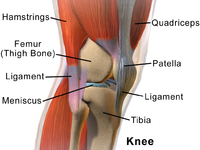
Photo from wikipedia
Background Subtrochanteric or supracondylar femoral rotational osteotomies are established surgical treatments for femoral rotational deformities. Unintended change of the mechanical leg axis is an identified problem. Different attempts exist to… Click to show full abstract
Background Subtrochanteric or supracondylar femoral rotational osteotomies are established surgical treatments for femoral rotational deformities. Unintended change of the mechanical leg axis is an identified problem. Different attempts exist to plan a correct osteotomy plane, but implementation of the preoperative planning into the surgical situation can be challenging. Goal of this study was to identify the critical threshold of mal-angulation of the osteotomy plane and of femoral rotation that leads to a relevant deviation of the postoperative mechanical leg axis using a computer simulation approach. Methods Three-dimensional (3D) surface models of the lower extremity of two patients (Model 1: 42° femoral antetorsion; Model 2: 6° femoral retrotorsion) were generated from computed tomography data. First, baseline subtrochanteric and supracondylar rotational osteotomies, perpendicular to the femoral mechanical axis were simulated. Afterwards, mal-angulated osteotomies in sagittal and frontal plane followed by different degrees of rotation were simulated and frontal mechanical axis was analyzed. Results 400 mal-angulated osteotomies have been simulated. Mal-angulation of ±30° with 30° rotation showed maximum deviation from preoperative mechanical axis in subtrochanteric osteotomies (4.0° ± 0.4°) and in supracondylar osteotomies (12.4° ± 0.8°). Minimal mal-angulation of 15° in sagittal plane in subtrochanteric osteotomies and mal-angulation of 10° in sagittal plane in supracondylar osteotomies altered the mechanical axis by > 2°. Mal-angulation in sagittal plane showed higher deviations of the mechanical axis (up to 12.4° ± 0.8°), than in frontal plane mal-angulation (up to 4.0° ± 1.9°). Conclusion A femoral rotational osteotomy, perpendicular to the femoral mechanical axis, has no considerable influence on the mechanical leg axis. However, mal-angulation of femoral rotational osteotomies showed relevant changes of the mechanical leg axis. In supracondylar respectively subtrochanteric procedures, mal-angulation of only 10° in combination with already 15° of femoral rotation respectively mal-angulation of 15° in combination with 30° of femoral rotation, can lead to a relevant postoperative mechanical leg axis deviation of more than 2°, wherefore these patients probably would benefit from the use of navigation aids.
Journal Title: BMC Musculoskeletal Disorders
Year Published: 2020
Link to full text (if available)
Share on Social Media: Sign Up to like & get
recommendations!